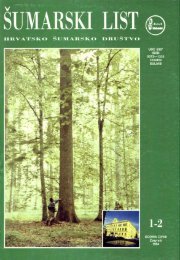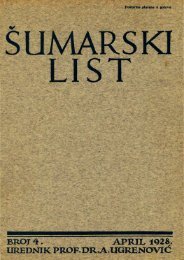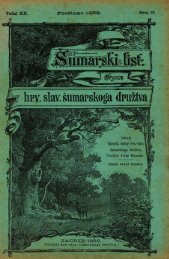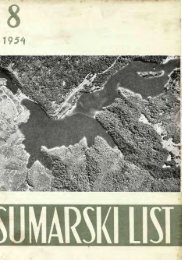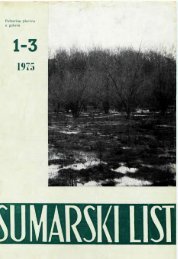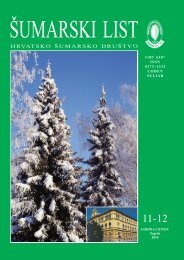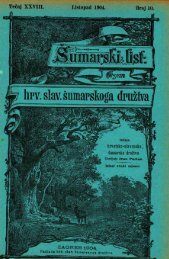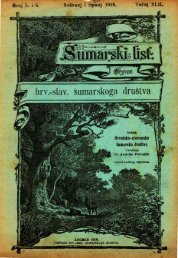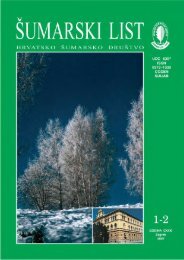Å UMARSKI LIST 1-2/1962
Å UMARSKI LIST 1-2/1962
Å UMARSKI LIST 1-2/1962
- No tags were found...
You also want an ePaper? Increase the reach of your titles
YUMPU automatically turns print PDFs into web optimized ePapers that Google loves.
LITERATURA1. Bel Ion, S.: 1954 Winiki dotychczasowych observaciji nad wzrostem mieszancamodrzewia Larix eurolepis (Larix leptolepisxLarix europaea) na terenie lasöwdoswiadczainych SGGW w Rogowie, Sylwan 98 (4).2. Dimpf lrneier, R.: 1959 Die Bastardierung in der Gattung Larix, Forstwiss.Forschungen, Beih. z. Forstw. Centralblatt 12.3. Edwards, M. V.: 1956 The hybrid Larch x Larix eurolepis Henry, Forestry29 (1).4. Go the, H.: 1953 Ein Kreuzungsversuch mit Larix eurcpaea D. C, HerkunftSchlitz und Larix leptolepis Gord., Z. Forstgenetik 2 (6).5. Go the, H.: 1956 Ein Kreuzungsversuch mit Larix europaea D. C, HerkunftSchlitz und Larix leptolepis Gord., Z. Forstgenetik 5 (4).6. Kiellander, L. C: 1956 Report on the Development of the InternationalProvenance Test of Larch in Sweden, JUFRO, 12th Congress, Oxford.7. Kiellander, L. C: 1958 Hybridlärk och lärkhybrider, Svenska SkogsvardsföreningensTidskrift 4.8 Langner, W.: 1951-52 Kreuzungsversuche mit Larix europaea D. C. und Larixleptolepis Gord., Z. Forstgenetik 1 (1, 2).9. Langner, W.: 1961 Einige Versuchsergebnisse zum Inzuchtproblem bei derforstlichen Saatgutgewinnung, JUFRO, 13. Kongress, Wien.10. L e v e n, J. K.: 1949 Some experiments in cross pollination of European Larch(L. europaea D. C.) and Japanese Larch (L. leptolepis Murray), Quart. J. Fort.43 (2).11. V i d a k o v i ć, M.: 1959 Oplemenjivanje ariša, Šumarski list, 10—11.A NEW CONTRIBUTION TO THE BREEDING OF LARCHIn 1957 the author carried out artificial pollination of Larch trees. In the paper(11) are presented the results of measurements of the seedlings-crosses after the firstyear of age. Now the author presents the results of measurements of these seedlingswhen 3 years old.In the Table I are shown the combinations of the performed artificial pollination.The height data referring to the seedlings are given in Tables II, III, IV, and V, aswell as in a histogram. The diameter of the seedlings was measured after the secondand third growing seasons. It was measured close to the ground surface. Data relatingthereto are shown in Tables VI, VTI, VIII, and IX, as well as in a histogram.On the basis of these results the author came to the following conclusions:1. Interspecific hybrids — for which an European or Siberian Larch was takenas the female parent, and a Japanese Larch as the male parent — exhibit a goodrate of height growth while their diameter growth is somewhat inferior.2. The hybrid Si produced by crossing European Larch No. 12 x Japanese LarchNo. 10 displays the best height growth, evidencing in this connection the phenomenonof heterotic vigour.3. For the parent tree of European Larch No. 12 it is supposed that it possessesthe character of good height and diameter growth, this being based on the followingfindings:a) The Fi-generation of this tree obtained by self fertilization possesses a good.height and diameter growth rate.b) The cross iSi, for which the parent tree No. 12 was taken as the female parent,exhibits the best height growth among all other combinations, and as to the diametergrowthit is better than is in the case of the cross Sio, in which for the female parentwas taken a tree of the European Larch No. 29 (instead of the No. 29), while the maleparent is the same as in the combination Si.4. It is supposed that the second parent tree of European Larch No. 29 possesses,a somewhat inferior height growth (and especially as to the diameter growth) thanEuropean Larch No. 12.5. In the progeny of all combinations the dispersion is smaller round the mean,diameters then round the mean heights.62




